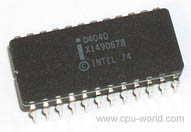Hello, each one no matter who who is a narrow disciple of this blog will know that it is my second on the post on the nut of technology. (Well, maintaining each one knows differently as well). Without more delay I would like to give a small introduction to this post - as the major part of the people knows that Intel is one of the most famous companies of today in the field of the microprocessors and reached a size where it is competed per few others (AMD for example). However little would worry about knowing the history to the top of the processors of Intel. I gave the line below and will speak about the first four processors (source: Wikipedia).
4004. 4040. 8008. 8080. 8085. iAPX 432. i860. i960. 8086. 8088. 80186. 80188. 80286. 80386. 80486. Pentium. Pentium pro. Pentium II. Pentium III. Itanium. Pentium 4. Pentium D. Pentium Extreme Edition. Pentium Mr. Duel-Core of Pentium. Core. Core 2. Celeron. Xeon. XScale. Itanium 2
�
Intel 4004

Intel 4004, is a central processing unit of treatment of 4 bits (central processing unit of treatment) released by Intel Corp. in 1971, the first microprocessor of only one commercial piece of the world is largely considered. The 4004 used a technology of silicon-carries PMOS (p-type semiconductor metal oxidizes 10.m) and could carry out 60.000 instructions roughly a second.
The 4004 were released in 16 pin CERDIP packing up on November 15, 1971. The 4004 is the first processor of computer designed and built by the Intel chipmaker, who previously made memory chips of semiconductor. The originators as a chief of the piece were Federico Faggin (project manager and originator of chips) and Ted Hoff (architecture) of Intel and Masatoshi Shima de Busicom (later of ZiLOG). Shima conceived the software packages of computer of Busicom and helped Faggin during the execution.
At the origin conceived for Japanese Busicom company to be used in their line of computer (instead of the complex tiddlywinks of computer of special goal that Busicom had been conceived and brought to Intel to have made, that Intel given was too complex to make with technology they had then), the 4004 were also equipped with family of the pieces realized on order of support ( for example, each �ROMANIAN of program� internally locked for its personal use the keynote speech of bit 4004 ' S 12, which left 4 KBs of access report of the adress bus of bit 4 if each of the 16 ROMANIANS were installed). Circuit 4004 was established of 2.250 transistors, and was followed the next year of the first microprocessor to 8 bits, 3.300 transistor 8008 (and 4040, of the 4004 revised).
Now, after slightly of an introduction at Intel 4004 let to us come to the technical specifictions. (I still say that the majority of this were taken of Wikipedia and I feel that it is not any point taking the trouble of reading the whole article because I copied the whole article almost.) Intel 4004 had
- The maximum frequency of clock is of 740 kilocycles
- Separate storage of program and data (C. - with-D., an architecture of Harvard). The opposite with the majority of architecture of Harvard conceives, however, which uses the separated buses, the 4004, with its need to reduce the account of pin, of the uses a simple multiplexed bus of 4 bits for the transfer:
- 12 addresses of bit
- instructions with 8 bits
- 4 words containing of the data of bit
- The whole of instruction contains 46 instructions (of which 41 is 8 bits with far and 5 are 16 bits with far)
- The whole of register contains 16 registers of 4 bits each one
- The internal pile of sub-routine is 3 levels deeply
Microarchitecture and pinout

Architectural functional diagram of Intel 4004.
�

Intel 4004 PLUNGE the pinout of piece.
�
�
Pieces realized on order of support
- 4001: ROMANIAN of 256 bytes (256 program instructions to 8 bits), and a wearing of input-output of bit of the integrated function 4
- 4002: RAM of 40 bytes (80 4 words containing of the data of bit), and a port of output of bit of the integrated function 4; the part of RAM of the piece is organized in four �registers� of twenty 4 words of bit:
- 4003: shift register of output of parallel of bit 10 for keyboards of sweeping, postings, printers, etc
- 4008: bolt of address with 8 bits for the access to the standard memory chips, and a piece of bit of the integrated function 4 chosen and wearing of input-output
- 4009: program and converter of access of input-output to the standard memory and the pieces of input-output.
New devices
Prolongations
- The whole of instruction increased with 60 instructions
- The memory of program increased to 8 KiB
- The registers increased to 24
- The pile of sub-routine increased on 7 levels deeply
Originators
New pieces of support
- 4201 - The clock 500 generator to 740 kilocycles using of the crystals from 4 to 5.185 megahertz
- 4308 - 1 ROMANIAN of KiB
- 4207 - Port of output of universal use of byte
- 4209 - Input port of universal use of byte
- 4211 - Wearing of universal use of input-output of byte
- 4289 - Interface standard of memory (replaces 4008/4009)
- 4702 - 256 byte UVEPROM
- ROMANIANS of 4316 - of 2 KiB
- 4101 - 256 word RAM of 4 bits

No comments:
Post a Comment